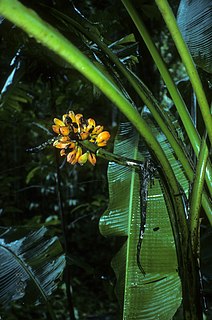
The blood banana, is a variety of the wild banana Musa acuminata native to Sumatra, Indonesia. The blood banana is an ornamental plant, named for the dark red patches on its leaves, though its small-seeded fruits are also edible. It grows 6' to 8' tall in the wild, but is well-adapted to container growing and can be maintained at 3' to 5'. It grows best in full or partial sun and is hardy in zones 9 - 11.

Musa is one of two or three genera in the family Musaceae. The genus includes flowering plants producing edible bananas and plantains. Around 70 species of Musa are known, with a broad variety of uses.

Musa acuminata is a species of banana native to Southern Asia, its range comprising the Indian Subcontinent and Southeast Asia. Many of the modern edible dessert bananas are from this species, although some are hybrids with Musa balbisiana. First cultivated by humans around 10 kya, it is one of the early examples of domesticated plants.
Musa maclayi is a species of seeded banana native to Papua New Guinea and the Solomon Islands. It is placed in section Callimusa. It is regarded as one of the progenitors of the Fe'i banana cultivars.
Musa tuberculata is a tropical Asian species of plant in the banana family native to the Malesian region (Brunei). It is one of fourteen species of Musa endemic to the island of Borneo. The specific epithet "tuberculata" is from the Latin meaning "covered with minute tubercles". M. tuberculata is placed in section Callimusa, members of which have a diploid chromosome number of 2n = 20.
Musa × alinsanaya is a Malesian tropical plant in the banana family (Musaceae), native to the Philippines. Only formally named in 2004, it is considered to be a hybrid between Musa banksii and Musa textilis. The flower bud is shiny green with purple inside. It produces small fruit with a high proportion of seeds.
Musa salaccensis, commonly called Javanese wild banana, is a Malesian tropical species of plant in the banana family native to the islands of Sumatra and Java, in Indonesia. It is placed in section Callimusa, members of which have a diploid chromosome number of 2n = 20.
Musa paracoccinea is a tropical and subtropical Asian species of plant in the banana family native to both China and Indochina. It is placed in section Callimusa, members of which have a diploid chromosome number of 2n = 20.

Fe'i bananas are cultivated plants in the genus Musa, used mainly for their fruit. Unlike most other cultivated bananas they are diploids of the AA-type. They are very distinct in appearance and origin from the majority of bananas and plantains currently grown. Found mainly in the islands of the Pacific, particularly French Polynesia, Fe'i bananas have skins which are brilliant orange to red in colour with yellow or orange flesh inside. They are usually eaten cooked and have been an important food for Pacific Islanders, moving with them as they migrated across the ocean. Most are high in beta-carotene.
Musa muluensis is a plant in the banana and plantain family. It is native to tropical Asia; found only in Sarawak in Malaysia. It is placed in section Callimusa, members of which have a diploid chromosome number of 2n = 20.
Musa hirta is a tropical Asian species of plant in the banana family native to Sarawak on the island of Borneo, in Malaysia. It is one of fourteen species of Musa endemic to the island of Borneo. It is placed in section Callimusa, having a diploid chromosome number of 2n = 20.

Musa coccinea, commonly known as scarlet banana or red-flowering banana, is a species of flowering plant in the banana and plantain family Musaceae, native to tropical China and Vietnam. It is a bat-pollinated evergreen perennial, placed in section Callimusa, having a diploid chromosome number of 2n = 20.
Musa bukensis is a species of wild banana from the Solomon Islands. It is placed in section Callimusa, having a diploid chromosome number of 2n = 20.

Musa beccarii is a species of wild banana, found in Malaysia, in Sabah. It is placed in section Callimusa. The flower bud is narrow, bright scarlet with green-tipped bracts. The fruit is green and thin. The species is named after Italian naturalist Odoardo Beccari.
Musa jackeyi is a species of wild banana. It is placed in section Callimusa. It has only a small native range in north-east Queensland, Australia. It resembles the cultivated bananas called "fe'i" or "fehi", having an upright rather than a drooping fruit stalk, with the green terminal bud pointing upwards, and sap which is reddish in colour.
Musa boman is a species of wild banana, native to the West Sepik (Sandaun) Province of Papua New Guinea, in the eastern portion of the island of New Guinea. It is placed in section Callimusa, having a diploid chromosome number of 2n = 20. The male bud is cream in colour.
Musa borneensis is a species of wild banana, native to the island of Borneo, in the Malaysian states of Sabah and Sarawak. It is placed in section Callimusa, having a diploid chromosome number of 2n = 20.

Musa gracilis is a species of wild banana, native to Peninsular Malaysia. It is placed in section Callimusa, having a diploid chromosome number of 2n = 20. It grows to less than 2 m (7 ft) tall. It has an upright pink-purple bud and produces narrow fruits (bananas), which have magenta and green stripes.
Musa lawitiensis is a species of wild banana, native to the island of Borneo. It is placed in section Callimusa, having a diploid chromosome number of 2n = 20.

Musa lolodensis is a species of wild banana, occurring naturally from the Moluccas through to New Guinea. It is placed in section Callimusa, having a diploid chromosome number of 2n = 20. It is one of the possible parents of the cultivated Fe'i bananas.








